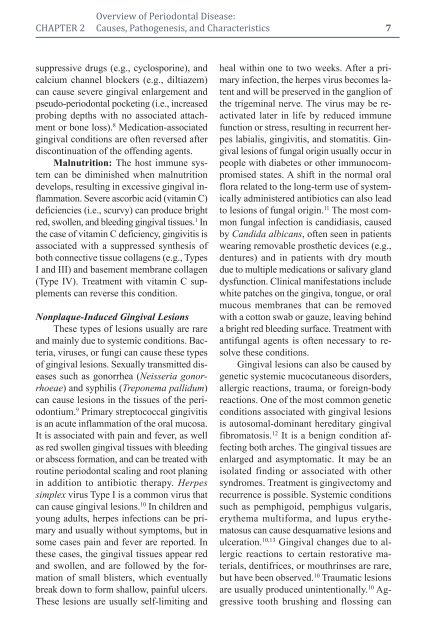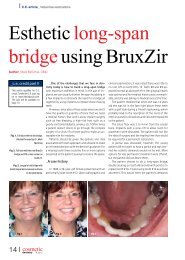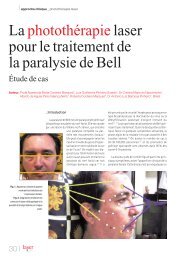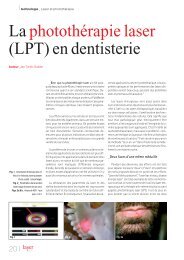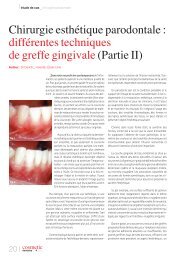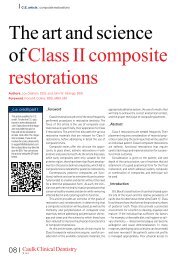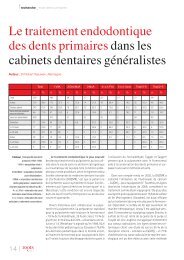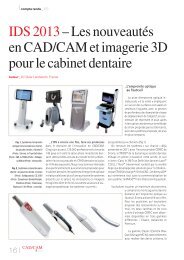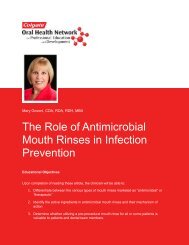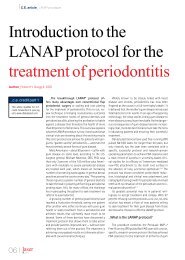Periodontal Disease and Overall Health: A Clinician's Guide
Periodontal Disease and Overall Health: A Clinician's Guide
Periodontal Disease and Overall Health: A Clinician's Guide
You also want an ePaper? Increase the reach of your titles
YUMPU automatically turns print PDFs into web optimized ePapers that Google loves.
CHAPTER 2 Overview of <strong>Periodontal</strong> <strong>Disease</strong>:CHAPTER 2 Causes, Pathogenesis, <strong>and</strong> Characteristics 7suppressive drugs (e.g., cyclosporine), <strong>and</strong>calcium channel blockers (e.g., diltiazem)can cause severe gingival enlargement <strong>and</strong>pseudo-periodontal pocketing (i.e., increasedprobing depths with no associated attachmentor bone loss). 8 Medication-associatedgingival conditions are often reversed afterdiscontinuation of the offending agents.Malnutrition: The host immune systemcan be diminished when malnutritiondevelops, resulting in excessive gingival inflammation.Severe ascorbic acid (vitamin C)deficiencies (i.e., scurvy) can produce brightred, swollen, <strong>and</strong> bleeding gingival tissues. 1 Inthe case of vitamin C deficiency, gingivitis isassociated with a suppressed synthesis ofboth connective tissue collagens (e.g., TypesI <strong>and</strong> III) <strong>and</strong> basement membrane collagen(Type IV). Treatment with vitamin C supplementscan reverse this condition.Nonplaque-Induced Gingival LesionsThese types of lesions usually are rare<strong>and</strong> mainly due to systemic conditions. Bacteria,viruses, or fungi can cause these typesof gingival lesions. Sexually transmitted diseasessuch as gonorrhea (Neisseria gonorrhoeae)<strong>and</strong> syphilis (Treponema pallidum)can cause lesions in the tissues of the periodontium.9 Primary streptococcal gingivitisis an acute inflammation of the oral mucosa.It is associated with pain <strong>and</strong> fever, as wellas red swollen gingival tissues with bleedingor abscess formation, <strong>and</strong> can be treated withroutine periodontal scaling <strong>and</strong> root plan ingin addition to antibiotic therapy. Herpessimplex virus Type I is a common virus thatcan cause gingival lesions. 10 In children <strong>and</strong>young adults, herpes infections can be primary<strong>and</strong> usually without symptoms, but insome cases pain <strong>and</strong> fever are reported. Inthese cases, the gingival tissues appear red<strong>and</strong> swollen, <strong>and</strong> are followed by the formationof small blisters, which eventuallybreak down to form shallow, painful ulcers.These lesions are usually self-limiting <strong>and</strong>heal within one to two weeks. After a primaryinfection, the herpes virus becomes latent<strong>and</strong> will be preserved in the ganglion ofthe trigeminal nerve. The virus may be reactivatedlater in life by reduced immunefunction or stress, resulting in recurrent herpeslabialis, gingivitis, <strong>and</strong> stomatitis. Gingivallesions of fungal origin usually occur inpeople with diabetes or other immunocompromisedstates. A shift in the normal oralflora related to the long-term use of systemicallyadministered antibiotics can also leadto lesions of fungal origin. 11 The most commonfungal infection is c<strong>and</strong>idiasis, causedby C<strong>and</strong>ida albicans, often seen in patientswearing removable prosthetic devices (e.g.,dentures) <strong>and</strong> in patients with dry mouthdue to multiple medications or salivary gl<strong>and</strong>dysfunction. Clinical manifestations includewhite patches on the gingiva, tongue, or oralmucous membranes that can be removedwith a cotton swab or gauze, leaving behinda bright red bleeding surface. Treatment withantifungal agents is often necessary to resolvethese conditions.Gingival lesions can also be caused bygenetic systemic mucocutaneous disorders,allergic reactions, trauma, or foreign-bodyreactions. One of the most common geneticconditions associated with gingival lesionsis autosomal-dominant hereditary gingivalfibromatosis. 12 It is a benign condition affectingboth arches. The gingival tissues areenlarged <strong>and</strong> asymptomatic. It may be anisolated finding or associated with othersyndromes. Treatment is gingivectomy <strong>and</strong>recurrence is possible. Systemic conditionssuch as pemphigoid, pemphigus vulgaris,erythema multiforma, <strong>and</strong> lupus erythematosuscan cause desquamative lesions <strong>and</strong>ulceration. 10,13 Gingival changes due to allergicreactions to certain restorative ma -terials, dentifrices, or mouthrinses are rare,but have been observed. 10 Traumatic lesionsare usually produced unintentionally. 10 Aggressivetooth brushing <strong>and</strong> flossing can


